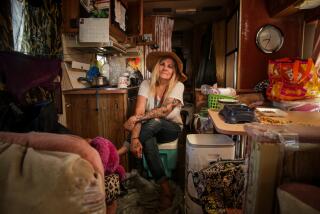Mayor Kills Plan at Last Minute for Skid Row Toilets
- Share via
The question is, where should homeless people go . . . when they need to go?
There are few easy answers on Skid Row, where a plan to scatter 33 portable toilets on the sidewalks of downtown Los Angeles was scuttled at the last minute Wednesday by Mayor Tom Bradley.
The seemingly straightforward approach to cleaning up despoiled public streets and alleys ran into problems after business owners raised a stink about the proposal, voicing fears that the toilets would become havens for drug addicts and breeding places for filth and disease.
“Treaties drawn between countries after war are probably simpler than the bathroom problem,” said Alice Callaghan, an advocate for the homeless who has lobbied for portable potties for nearly five years. “It’s astounding.”
Armed with a $23,000 funding agreement from the city’s housing department, a triumphant Callaghan had planned to begin placing the sidewalk latrines at key street corners on Friday.
That triumph, she expected, would have finally ended a six-month battle to clear one government hurdle after another. The non-locking, 24-hour outhouses were to have served roughly 50 square blocks of downtown, from 3rd to 7th streets and from Main to Alameda streets.
But as word of the plan got out early this week, business owners rallied against it, claiming that the toilets would become dirty hiding places for hoodlums and crack addicts who abound in the area. Their objections--raised in a petition signed by 108 business owners--prompted Bradley to intercede Wednesday, ordering the money withdrawn.
Though calling the shortage of restrooms for the homeless a major problem, Bradley said that a two-week effort to provide such facilities in 1987 was an “absolute failure.” At least two serious assaults took place in the unsecured facilities, he said.
“At this point, we’re just not moving forward,” said Gary Squier, head of the housing department.
This latest turn of events left a frustrated Callaghan vowing to continue the fight for city funding or for other money sources.
“It’s still hard for me to believe that the mayor of Los Angeles would deny . . . (people the chance to use) toilets on Skid Row,” said Callaghan, who runs Las Familias del Pueblo, a Skid Row community center for garment workers. “It reduces people on Skid Row to living the life of barbarians.”
But she added: “I see this as a temporary obstacle. I’m going to try to bring toilets to Skid Row by Christmas. It’s far from over.”
Under the proposal, the chemical toilets--which now sit on order in a storage yard in San Fernando--would have been placed on Skid Row for three months in a pilot project. At the end of that period, city officials would have had to evaluate whether they were worth the additional funding required to clean them each day.
Callaghan, who first approached Bradley’s office about the toilets five years ago, said she had tried to win approval for the project from dozens of officials, merchants and other service providers.
At one point, with the help of county Supervisor Gloria Molina and a pro bono attorney from the law firm of Paul, Hastings, Janofsky & Walker, Callaghan was even able to win an exemption from county public health codes prohibiting portable toilets on sidewalks.
She pointed out that Los Angeles City Councilwoman Rita Walters, who represents a portion of Skid Row, staunchly supports public toilets. At the same time, though, Councilman Richard Alatorre, who represents the remainder of the area, has expressed serious concerns about how they would be supervised.
“It’s just amazing,” Callaghan said. “We had to get everyone’s endorsement short of the Pope. And I would have tried that, if I thought it would help.”
Though business owners have voiced chronic complaints about street people urinating and defecating in streets, alleys and doorways, many merchants feared that the toilets would become used as miniature cocaine dens by addicts and for trysts by prostitutes. The structures ordered by the city were designed to accommodate no more than one person at a time.
Some merchants also questioned the city’s ability to keep the toilets clean enough to prevent health problems and stench.
“They’re going to need toilet paper continuously,” said printer Jess Markey. “There’s going to be a huge volume of people. I know for a fact that within a couple of hours, they’re going to be a mess.”
The skeptics have also skirmished with Callaghan over 102 signatures that she collected from business owners who she claims favor the toilets. Her critics said that many of those signatures came from Asian-speaking merchants in the toy district who did not understand what they were signing.
Callaghan denied that her supporters were confused.
As the quarrel continues, Skid Row residents say the toilets are long overdue.
“It’s stupid not to have them,” groused Lisa Jones, 23, who was interviewed on a busy section of 5th Street where the homeless often congregate. “It’s better than using the sidewalk. It’s common sense.”
Donald Williams, 50, who was among scores of the homeless who woke up Wednesday morning at the intersection of 5th and Crocker Avenue, where the first outhouse was scheduled to go, complained about the lack of privacy.
“You may be homeless, but some people still have some pride, some dignity,” he said. “It’s humiliating for both sexes.”
Nearby, Cecil Miller, 62, sold handmade silk flowers from a wheelchair while recovering from a broken leg. He said the homeless now resort to hiding behind cars or in alleys to relieve themselves.
“(But) they’re closing all the alleys around here--putting up fences,” he said. “There’s no place to go.”
More to Read
Sign up for Essential California
The most important California stories and recommendations in your inbox every morning.
You may occasionally receive promotional content from the Los Angeles Times.










